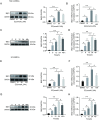Estrogen inhibits colonic smooth muscle contractions by regulating BKβ1 signaling
- PMID: 37948436
- PMCID: PMC10637685
- DOI: 10.1371/journal.pone.0294249
Estrogen inhibits colonic smooth muscle contractions by regulating BKβ1 signaling
Abstract
The estrogen inhibits colonic smooth muscle contractions, which may lead to constipation. However, the mechanisms of inhibition are poorly understood. Therefore, the present study examined the effect of estrogen on rat colonic smooth muscle contractions and its potential association with the large-conductance Ca2+-activated K+ channels β1 (BKβ1) subunit. Twenty-four female Sprague Dawley rats were randomly assigned to 4 groups. After 2 weeks of intervention, the contraction activity of isolated colonic smooth muscle and the expression of BKβ1 in colonic smooth muscle of rats were detected. Additionally, in order to investigate the effects of estrogen on BKβ1 expression and calcium mobilization, in vitro experiments were conducted using rat and human colonic smooth muscle cells (SMCs). BKβ1 shRNA was used to investigate whether calcium mobilization is affected by BKβ1 in colonic SMCs. To explore the relationship between ERβ and BKβ1, serial deletions, site-directed mutagenesis, a dual-luciferase reporter assay, and chromatin immunoprecipitation assays were employed. In response to E2, colonic smooth muscle strips showed a decrease in tension, while IBTX exposure transiently increased tension. Furthermore, in these muscle tissues, BKβ1 and α-SMA were found to be co-expressed. The E2 group showed significantly higher BKβ1 expression. In cultured colonic SMCs, the expression of BKβ1 was found to increase in the presence of E2 or DPN. E2 treatment reduced Ca2+ concentrations, while BKβ1 shRNA treatment increased Ca2+ concentrations relative to the control. ERβ-initiated BKβ1 expression appears to occur via binding to the BKβ1 promoter. These results indicated that E2 may upregulate BKβ1 expression via ERβ and inhibit colonic smooth muscle contraction through ERβ by directly targeting BKβ1.
Copyright: © 2023 Wen et al. This is an open access article distributed under the terms of the Creative Commons Attribution License, which permits unrestricted use, distribution, and reproduction in any medium, provided the original author and source are credited.
Conflict of interest statement
The authors have declared that no competing interests exist
Figures






Similar articles
-
Estrogen regulates the expression of small-conductance Ca-activated K+ channels in colonic smooth muscle cells.Digestion. 2015;91(3):187-96. doi: 10.1159/000371544. Epub 2015 Mar 14. Digestion. 2015. PMID: 25790748
-
Estrogen-regulated expression of SK3 channel in rat colonic smooth muscle contraction.Life Sci. 2020 Dec 15;263:118549. doi: 10.1016/j.lfs.2020.118549. Epub 2020 Oct 9. Life Sci. 2020. PMID: 33039385
-
[Estradiol regulates the expression of small conductance Ca(2)+ activated K(+) channel 3 in rat colonic smooth muscle cells in an estrogen receptor α-dependent manner].Zhonghua Yi Xue Za Zhi. 2013 Aug 13;93(30):2367-71. Zhonghua Yi Xue Za Zhi. 2013. PMID: 24300204 Chinese.
-
Estrogen increases the expression of BKCa and impairs the contraction of colon smooth muscle via upregulation of sphingosine kinase 1.J Cell Physiol. 2023 Oct;238(10):2390-2406. doi: 10.1002/jcp.31106. Epub 2023 Aug 29. J Cell Physiol. 2023. PMID: 37642352
-
Mechanisms of cellular synchronization in the vascular wall. Mechanisms of vasomotion.Dan Med Bull. 2010 Oct;57(10):B4191. Dan Med Bull. 2010. PMID: 21040688 Review.
Cited by
-
Association between defecation status and the habit of eating vinegar-based dishes in community-dwelling Japanese individuals: a cross-sectional study.Sci Rep. 2025 Mar 28;15(1):10732. doi: 10.1038/s41598-025-95618-2. Sci Rep. 2025. PMID: 40155513 Free PMC article.
-
Sex-specific post-inflammatory dysbiosis mediates chronic visceral pain in colitis.Gut Microbes. 2024 Jan-Dec;16(1):2409207. doi: 10.1080/19490976.2024.2409207. Epub 2024 Oct 3. Gut Microbes. 2024. PMID: 39360560 Free PMC article.
References
Publication types
MeSH terms
Substances
LinkOut - more resources
Full Text Sources
Miscellaneous

